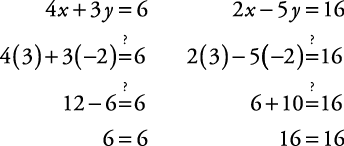Published On:Friday, 9 December 2011
Posted by Muhammad Atif Saeed
Linear Equations: Solutions Using Graphing with Two Variables
Linear Equations: Solutions Using Graphing with Two Variables
Example 1
Solve this system of equations by graphing.
Check the solution.

Figure 1. Two linear equations.

Here are two things to keep in mind:
- Dependent system. If the two graphs coincide—that is, if they are actually two versions of the same equation—then the system is called a dependent system, and its solution can be expressed as either of the two original equations.
- Inconsistent system. If the two graphs are parallel—that is, if there is no point of intersection—then the system is called an inconsistent system, and its solution is expressed as an empty set {}, or the null set, ⊘.









